Users Manual
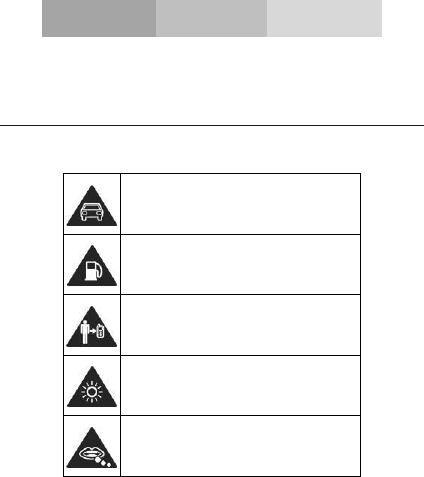
SECURITY INFORMATION
Please remember to obey relevant rules and regulations
whenever use your phone. This will prevent bad effect from
you and the environment.
General security
Don’t make or receive handheld calls
while driving. And never text while
driving.
Don’t use at petrol stations.
Keep your phone at least 15 mm away
from your ear or body while making
calls.
Your phone may produce a bright or
flashing light.
Small parts may cause a choking.
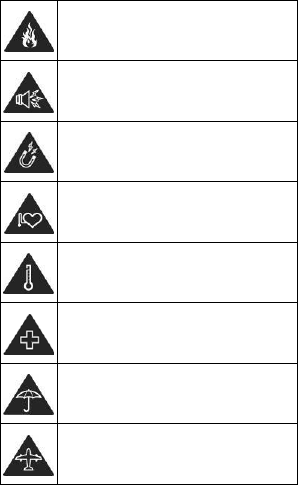
Don’t dispose of your phone in fire.
Your phone can produce a loud sound.
Avoid contact with anything magnetic.
Keep away from pacemakers and other
electronic medical devices.
Avoid extreme temperatures.
Switch off when asked to in hospitals
and medical facilities.
Avoid contact with liquids. Keep your
phone dry.
Switch off when told to in aircrafts and
airports.

Don’t take your phone apart.
Switch off when near explosive
materials or liquids.
Only use approved accessories.
Don’t rely on your phone for emergency
communications.

INTRODUCING YOUR MOBILE PHONE
Learn about your mobile phone’s layout, keys, display and
icons.
Unpacking
Check the product box for the following items:
Mobile phone
Battery
Travel adapter (charger)
User manual
The supplied accessories perform best for your phone.
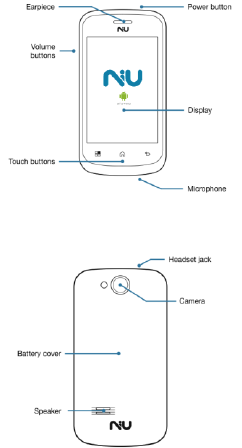
Phone layout
From the front view of your phone you will observe the
following elements:
From the front view of your phone you will observe the
following elements:

Keys
The following table offers you a quick description about the
phone’s keys:
Key Function
Power button
Allow you to turn on/off the device and
to lock the screen.
Volume
Allow you to adjust the volume of
ringing and notifications. Also allows
you to adjust the volume of multimedia
content playback.
Back
Allow you to return to the previous
menu or screen. Also allow you to close
some applications.
Home
It takes you directly to the home screen,
leaving any application open.
Menu
Allow you to access to the functions
menu of the application or screen you
are.
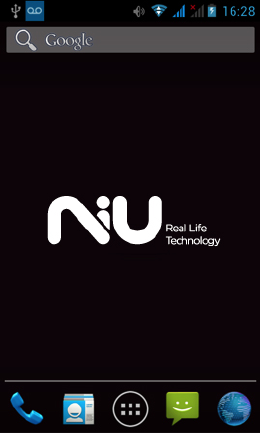
Screen
The screen of your mobile phone is designed as follows:
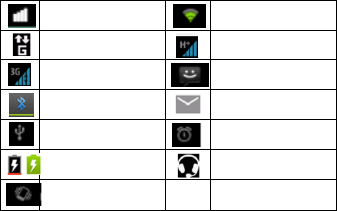
Icons
Learn about the icons that are displayed on the top of the
screen, indicating the status of the phone:
Signal strength Wi-Fi connection
GPRS connected
3G connected
HSPA connected
Bluetooth On
New message
USB connected
New email
Battery meter
Alarm active
Vibration profile
Headset connected
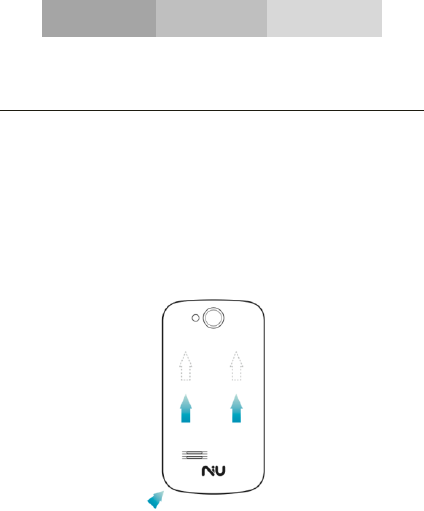
PREPARING YOUR MOBILE PHONE
Get started setting up your mobile phone for its first use.
Install the SIM cardand battery
When you subscribe to a cellular service, you will receive a
Subscriber Identity Module (SIM) card, with subscription
details, such as your personal identification number (PIN) and
optional services.
To install the SIM card and battery,
1. Remove the battery cover.
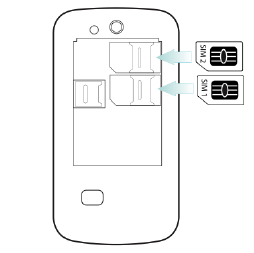
2. Insert the SIM card.
Your phone has 2 SIM card slots to allow you use 2 SIM
cards and switch between them.
Place the SIM card in the phone with the gold-colored
contacts facing down.
Without inserting a SIM card, you can use your phone’s
non-network services and some menus.
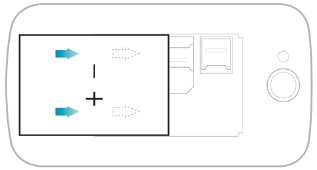
3. Insert the battery.
4. Replace the battery cover
Insert a memory card (optional)
To store additional multimedia files, you must insert a
memory card.
Your phone accepts memory cards up to 32 GB (depending
on memory card manufacturer and type).
Formatting the memory card on a PC may cause
incompatibility with your phone. Format the memory
card only on the phone.
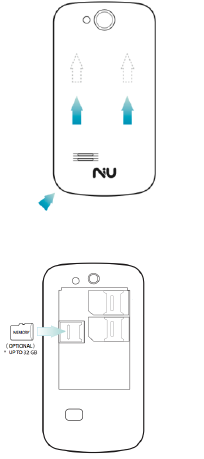
1. Remove the battery cover.
2. Insert a memory holder with the label side facing up.

USING BASIC FUNCTIONS
Learn how to perform basic operations of your mobile phone.
Turn your phoneon and off
To turn your phone on,
1. Long press the power button [ ] on the left side of your
phone.
2. Type in your PIN number and press OK (if it is needed).
To shut down your phone, go to step 1 above.
Access menus and applications
To get access to the Menu and Applications,
1. At the home screen, touch the button [ ] on the screen
to pop up the list of Installed Applications in your phone.
2. Slide your finger to the right or left to access other pages
of apps.
3. Touch any icon to enter to the application.
4. To exit the application, press Back or Home at the bottom
of the screen.

Use basic call functions
Learn to make or answer calls in this section
Make a call:
1. At the home screen or applications menu, touch the Phone
icon [ ].
2. Dial the area code and phone number.
3. Touch [ ] to start the call.
4. To end a call, touch [ ].
To answer a call:
1. When you receive a call, slide the phone icon to the right
to answer it or slide it to the left to reject it
[].
2. To end the call, touch [ ].
Send and view messages
In this section, learn how to send and receive:
- Text Messages (SMS).
- Multimedia Message (MMS).
Steps to send Text and Multimedia Messages:
1. Touch [ ] Messages at the application list, then touch

[ ] on the left bottom corner.
2. Type in the phone number or contact name on the field “To”
or touch [ ] to access to Contacts.
3. Type in your message in the field “Enter message”.
To send as text message go to step 5.
To attach a multimedia object (audio, image, etc.) continue to
step 4.
4. Touch [ ] on the top right corner, select the attach type
then choose the item.
5. Touch [ ] to send the message.
Add contacts
Learn the basics of using the phonebook feature.
Add a new contact:
1. In the application list touch Contacts, then touch [ ] on
the bottom right corner to add a new contact.
2. Fill the contact information (Name, Last name and phone
number). You can add more fields such as, email, address,
etc.
3. Touch [ ] on the top of the screen to save.

Search for a contact
1. In the application list touch [ ] Contacts.
2. Slide your finger from bottom to top to scroll the list or
touch the search button [ ] and type in the first letters of
the name or last name.
3. To see the contact details touch the name or the picture of
the contact.
If you want to call a contact touch the phone number.
Listen to music
Learn how to listen to music via the music player or FM radio.
Listen to the FM radio:
1. Plug in the earphones in your phone.
2. In the application list touch [ ] FM Radio.
3. Use the tool bar at the bottom to change of station.
Listen to music files:
First, copy the music files into your phone internal memory or
a MicroSD card.
1. In the application list, touch [ ] Music.
2. Select an order at the top of the screen and touch the song
that you want to listen to.

3. You can Pause, Loop, or change of song using the tool bar
at the bottom.
Browse the web
Learn how to access to your favorites Web Sites.
1. In the application list, touch [ ] Browser.
2. Touch the address bar and type in the address of the web
site you want to go and touch [ ] Go.
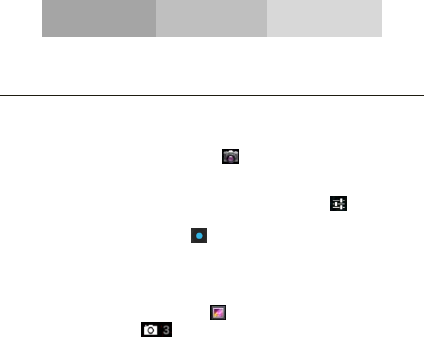
USING THE CAMERA
Learn the basics to capture and view photos.
Capture pictures
1. In the applications list, touch [ ] Camera.
2. Adjusts the lens at the photo target and make the desired
adjustments by touching the settings button [ ].
3. Touch the shot button [ ] on the screen to capture the
picture. It will be saved automatically.
See the captured pictures
In the applications list, touch [ ] Gallery and then select the
Camera folder [ ] to access and visualize all the
pictures captured by your phone.

CONNECTING TO INTERNET
Learn the basics to configure your phone and connect to
Internet.
Add a new connection
1. In the applications list, touch [ ] Settings to access to
the device configuration.
2. Touch the option “More…”, then touch Mobile networks
and touch APN. Now select the SIM Card that you want to
configure.
3. Touch the Menu key and select New APN then, type in the
parameters according with your Carrier.
The basic parameters are:
Account name
APN
Username
Password
Some carriers use Proxy Servers, refer to your carrier
configuration for more information.
4. When you finish typing in the parameters needed, touch
Menu then Save.

If you have multiples APN Configurations for the same SIM
card, choose which one you want to use touching the radio
button [ ] at the right side of the name.
To add another connection, repeat from step 3.
Switch between carriers
(SIM cards)
If you use multiple SIM cards and want to switch to another
one, follow these steps:
1. In the applications list, touch [ ] Settings to access to the
device configuration.
2. Touch SIM management [ ]
3. Choose the option Data Connection [ ] and
select the SIM Card that you want to use.
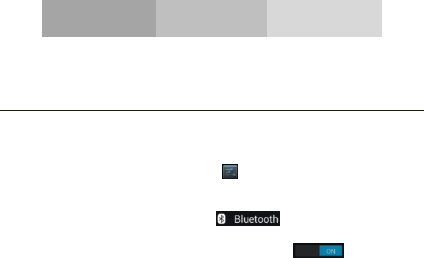
USING THE BLUETOOTH
Learn about your phone’s ability to connect to otherwireless
devices for exchanging data.
Turn on the Bluetoothwireless feature
1. In the applications list, touch [ ] Settings to access to
the device configuration.
2. Touch the Bluetooth option [ ].
3. To turn the Bluetooth touching the button [ ] on
the right top corner.
Find and pair with other Bluetooth enabled devices
1. When you turn the Bluetooth on, the list will show all the
available devices near you.
2. Touch the device that you want to pair with your phone.
3. Enter a PIN for the Bluetooth wireless feature or the other
device’s Bluetooth PIN, if it has one, and press OK.
When the owner of the other device enters the same code or
accepts the connection, the pairing will be complete.

Send images using the Bluetooth wireless feature
1. Open Gallery [ ].
2. Choose a picture and press Share [ ] on the top right
corner of the screen and select Bluetooth
[ ].
3. Touch the device that you want to send the picture then
accept the file in the receiver.
Receive images using the Bluetooth wireless feature
1. Turn on the Bluetooth at System Settings.
2. Type in the Bluetooth PIN or accept it (if it is needed).
3. Accept the receiving file if you want to receive data from
the other device.
When the transferring is finished you can see the picture
using the Gallery Application [ ].
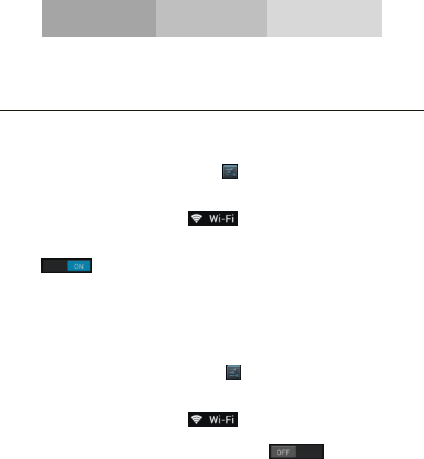
USING THE Wi-Fi
Learn to use the phone's wireless capabilities to connect to
any wireless local area network compatible.
Connect to a wireless network
1. In the applications list, touch [ ] Settings to access to
the device configuration.
2. Touch the Wi-Fi option [ ].
3. To turn the On the Wi-Fi touching the button
[ ] on the right top corner.
4. Choose a wireless network and enter the security
password if it is needed.
Disconnect from a wireless network
1. In the applications list, touch [ ] Settings to access to
the device configuration.
2. Touch the Wi-Fi option [ ].
3. To turn the Wi-Fi off touch the button [ ] on the
right top corner.

View the technical details of a wireless network
1. In the applications list, touch [ ] Settings to access to
the device configuration.
2. Touch the Wi-Fi option [ ].
3. Touch the active wireless network to see details such as
Link Speed, Signal strength and more.

FCC AND SAR
Please take time to read this important section.
FCC Caution
Any Changes or modifications not expressly approved by the
party responsible for compliance could void the user's
authority to operate the equipment.
This device complies with part 15 of the FCC Rules.
Operation is subject to the following two conditions: (1) This
device may not cause harmful interference, and (2) this
device must accept any interference received, including
interference that may cause undesired operation.
Note: This equipment has been tested and found to comply
with the limits for a Class B digital device, pursuant to part 15
of the FCC Rules. These limits are designed to provide
reasonable protection against harmful interference in a
residential installation.
This equipment generates, uses and can radiate radio
frequency energy and, if not installed and used in accordance
with the instructions, may cause harmful interference to radio
communications. However, there is no guarantee that
interference will not occur in a particular installation. If this
equipment does cause harmful interference to radio or
television reception, which can be determined by turning the
equipment off and on, the user is encouraged to try to correct
the interference by one or more of the following measures:
- Reorient or relocate the receiving antenna.
- Increase the separation between the equipment and
receiver.
- Connect the equipment into an outlet on a circuit different
from that to which the receiver is connected.
- Consult the dealer or an experienced radio/TV technician
for help.
Specific Absorption Rate (SAR) information
This model phone meets the government’s requirements for
exposure to radio waves.
This phone is designed and manufactured not to exceed the
emission limits for exposure to radio frequency (RF) energy
set by the Federal Communications Commission of the U.S.
Government:
The exposure standard for wireless mobile phones employs a
unit of measurement known as the Specific Absorption Rate,
or SAR. The SAR limit set by the FCC is 1.6W/kg. *Tests for
SAR are conducted using standard operating positions
accepted by the FCC with the phone transmitting at its
highest certified power level in all tested frequency bands.
For body worn operation, this model phone has been tested
and meets the FCC RF exposureguidelines when used with
an accessory designated for this product or when used with
an accessory that contains no metal and that positions the
handset a minimum of 1.0 cm from the body.
Non-compliance with the above restrictions may result in
violation of RF exposure guidelines.
Although the SAR is determined at the highest certified
power level, the actual SAR level of the phone while
operating can be well below the maximum value. This is
because the phone is designed to operate at multiple power
levels so as to use only the poser required to reach the
network. In general, the closer you are to a wireless base
station antenna, the lower the power output.
Before a new model phone is a available for sale to the public,
it must be tested and certified tothe FCC that it does not
exceed the exposure limit established by the FCC, Tests for
eachphone are performed in positions and locations (e.g. at
the ear and worn on the body)asrequired by the FCC.